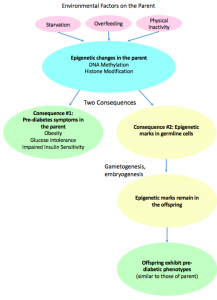Answer Overview
Overview of Epigenetics
Histone Modification
DNA in eukaryotic cells are arranged with proteins called histones. [1], [2] The NH2 terminal tails of the histones are modifiable; the most common histone modifications are acetylation and methylation of the lysine residues in the N termini of Histone 3 (H3) and Histone 4 (H4). [1], [2], [3]
Histone deacetylases (HDACs) remove and histone acetyl transferases (HATs) add acetyl groups to the lysine part of the histone tails. [1] Methylation histone affects gene activity in that K4 methylation of H3 will increase gene activity while methylation of K9 of H3 will decrease gene activity. [3]
DNA methylation
DNA methylation is often correlated with transcriptional silencing. The silencing can be brought upon by engaging proteins that bind to the methylated CGs that consequently engage histone deacetyltransferases (HDACs) and corepressors. [1]
DNA methylation is driven by DNA methyltransferases (DNMT). [3] Cytosine base is modified by DNMT at C5, mostly within CpG dinucleotides [2] , [3]. DNMT catalyzes the transfer of methyl part from S-adenosyl-L-methinione (SAM) to the C5 of cytosine in particular CpG dinucleotides. [3]
Find more information on Histone Modification and DNA Methylation Here.
Epigenetic Inheritance of Diabetes
Using an example to illustrate the mechanism of epigenetics, this website delves into the epigenetic inheritance of diabetes, which has been increasing in worldwide prevalence. Fundamentally, research in this field investigates the hypothesis that environmental factors induce epigenetic marks in parents, and that the offspring inherit those changes. [4] In the context of diabetes, environmental factors include starvation, overfeeding, and physical inactivity. [4] The consequent epigenetic marks change the expression levels of genes involved in glucose and lipid metabolism, magnifying the risk factors of diabetes, such as obesity and insulin resistance. [4] Some marks may remain in the affected individual’s germline cells even after gametogenesis and embryogenesis, and as the result, the offspring inherits the epigenetic changes and their corresponding metabolic phenotypes. [4] With the impact of the environment as well as the stability of epigenetic marks, diabetes can be inherited through an epigenetic mechanism.
 Figure 1. Hypothesis of the epigenetic inheritance of diabetes
Figure 1. Hypothesis of the epigenetic inheritance of diabetes
Find more information on Epigenetic Inheritance of Diabetes Here.
November 12, 2017 at 6:27 pm
I think it’d be helpful to clarify that H3 and H4 are histones (I assume) because H can be misunderstood as a histidine residue. It’d also be helpful to clarify HDAC =histone deacetylase in the first section rather than the second section.
I think in general, including some figures would be extremely helpful!
November 13, 2017 at 5:00 pm
I second Frank’s suggestions, a diagram of the Histone subunits interacting with a DNA molecule would clear things up quite nicely.